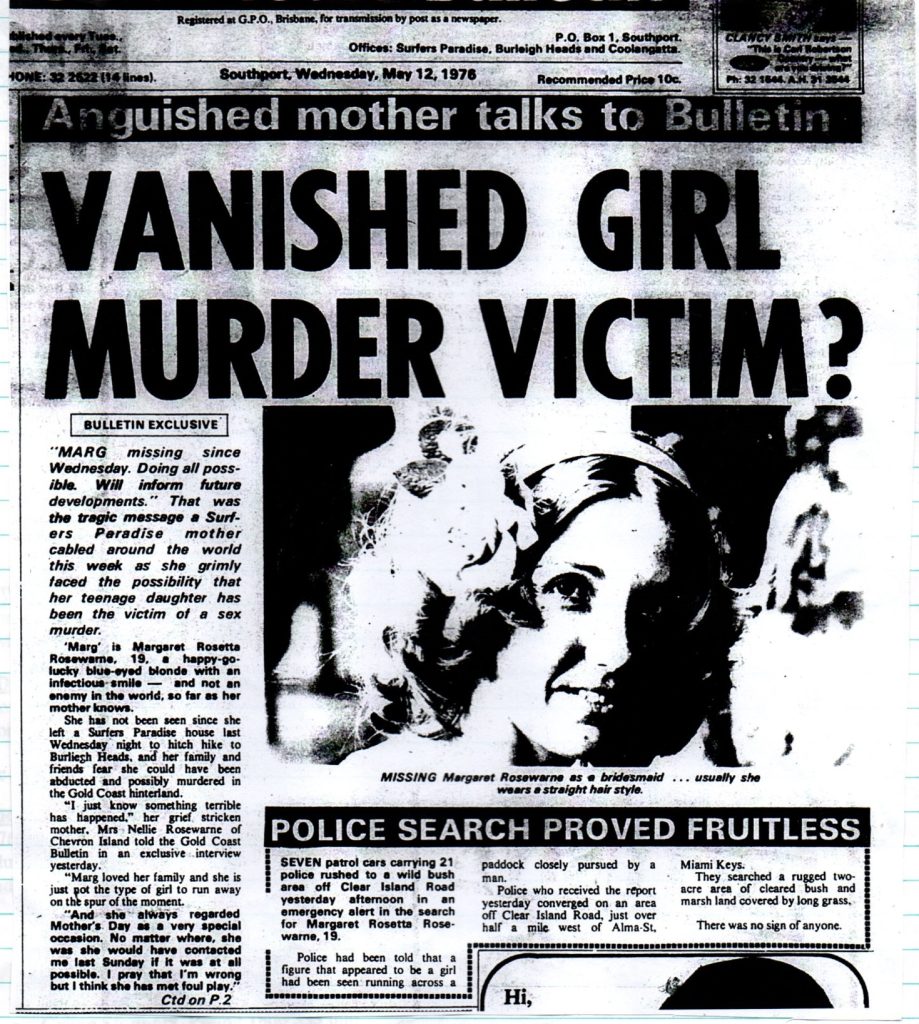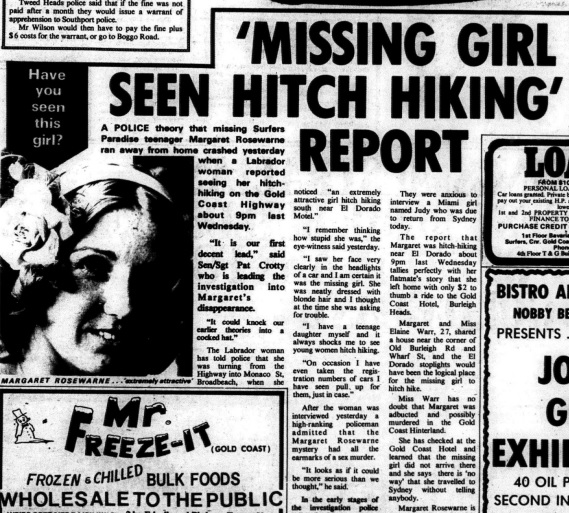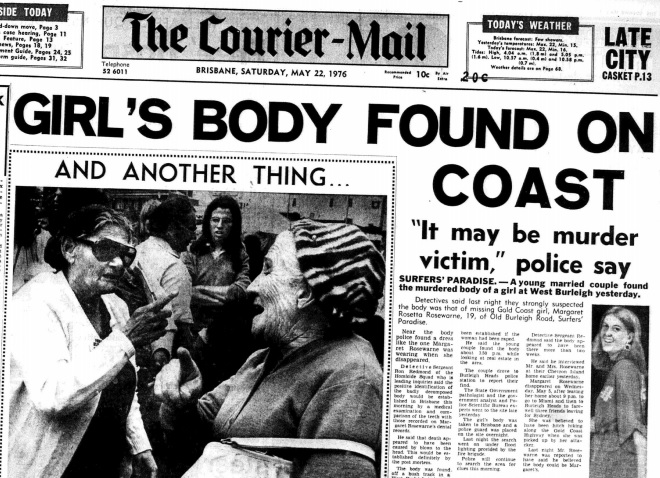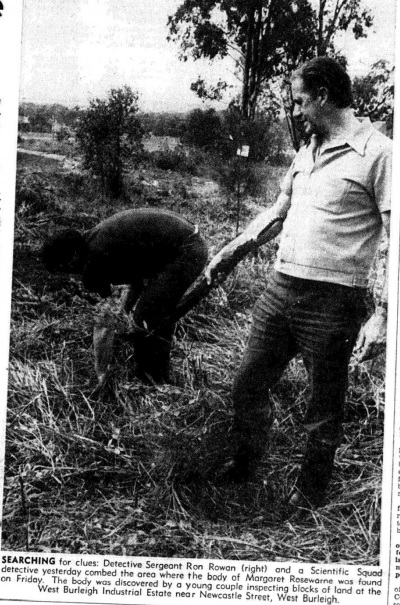
STORY BY GREG FOX – True Crime Researcher & Essayist
Sunday 9th May 1976 – Mother’s Day: They waited … and waited. The family home on Chevron Island channelling an impending doom. As the hours passed, the dread amplified to each member of the Rosewarne family, whether near or far. Where was Margie? And why had she not come home? Missing for the past 4 days, Mrs Nellie Rosewarne, Margie’s mum, had held out some hope that her daughter would visit to wish her a Happy Mother’s Day. But she never arrived….
As the second youngest of 12 children, Margaret Rosewarne, 19, was believed to have disappeared whilst attempting to hitchhike from Broadbeach to Burleigh Heads on the evening of Wednesday 5th May to meet with friends at the Lounge Bar of the Gold Coast Hotel. After not returning to her parent’s home on Mother’s Day, Nellie subsequently told local newspaper The Gold Coast Bulletin of her overwhelming concern about Margie’s whereabouts:
“I just know something terrible has happened… I think she has met foul play. No matter where she was, she would have contacted me last Sunday (Mother’s Day) – if it was at all possible. She is not the type of girl to run away on the spur of the moment”.
Margie would be described by friends and family as a care-free person with a vivacious personality. She liked to enjoy herself and made the most of living on the Gold Coast. But where was she? It would take another gut-wrenching 12 days for her whereabouts to be established. And when this question was finally answered the superficial veneer of the Gold Coast would be in tatters.

The mid-1970s must be considered the halcyon days of the Gold Coast. A growing region bathed in natural beauty with a variety of lifestyle options to indulge in – be it the endless stretch of white sandy coastline with it rolling swells or the pristine sub-tropical rainforest of the hinterland. For a young person like Margie this was a great time to be alive and indulge what was on offer. The expanding pub and club scene looked like real fun – almost a rite of passage before entering the mundane nine to five routine of adulthood.
To envision 1976 on the “glitter strip” you would bear witness to: white shoes, long lunches, meter maids, pinball parlours, milk bars, surf mats, sunbaking, silly cycles, panel vans, recently dug backyard pools, dole bludgers, big nights at the Playroom, across the Broadwater swims and newly built high rises coming out of the ground like imposing monoliths – paying homage to an emerging coastal economy. The movie blockbuster of the moment was “Jaws” and it would have an extended stay on the big screen at cinemas and drive-ins for several months. “Fernando” by ABBA was the number one singles hit on the Top 40 countdown of local radio station 4GG. The ongoing construction of the new Pacific Fair Shopping Centre at Broadbeach, promoted to be the largest retail outlet in the country, had created real excitement amongst the local population. To those who called the Gold Coast home, this was in many ways a kinder and simpler – but exciting time for the region. Aspiration was the order of the day.
Yet beneath the excess of sun, surf and fun lurked something more sinister. Someone seemingly out of tune with the welcoming, easy-going region. A man who compulsively cruised the roads of the Gold Coast looking for vulnerable young women to prey upon. An evil predator who was driven to kill.

Wednesday 5th May 1976 – The Night In Question: Even though it was a week night, Margie was keen to meet with friends for a farewell drink. The mid-week catch-up was planned for the Gold Coast Hotel on the highway at Burleigh Heads. Her friends (a female named Judy Bond and two male acquaintances) were due to leave for Sydney the following morning to commence an overseas holiday. Margie had arranged to go to the drinks by car, driven and accompanied by her flat-mate Elaine Warr. However, in a twist of fate, Elaine was unwell and decided to stay home for the evening. After taking about an hour to get ready, Margie impulsively set out on foot at approximately 9pm from their residence, located near the corner of Old Burleigh Road and Wharf Street Surfers Paradise, and proceeded down Wharf Street to the Gold Coast Highway to hitch a ride. According to Elaine, Margie was in “good spirits” when she left home. With her hair worn straight, she was stylishly wearing a calf length denim dress and slaps sandals. Margie was also in possession of her suede shoulder bag – typical of the bohemian look of the time. It was thought she had about $2 in her purse for her outing. In an eyewitness report that would in time be provided to police by a Labrador woman, it was claimed she saw an “extremely attractive girl” hitchhiking on the southbound lane of the highway near the front of the El Dorado Motel (where the Crowne Plaza Hotel is located today). This was to be the last known eyewitness sighting of Margie before her disappearance. Frustratingly there were no confirmed sightings of Margie entering a vehicle by the side of the road.
By Thursday night Elaine Warr started to get slightly anxious that Margie had not returned to their flat in Surfers Paradise. Then Friday, Margie’s boss called to see why she hadn’t shown up for her shift at a local fish & chip shop. It was at this time Elaine decided to go by Margie’s parent’s house to raise her concerns and see if they had been in touch with their daughter. The circumstances appeared worrisome as Margie had not taken any extra clothes or money, including her bank book, when she left for drinks on Wednesday evening. The initial theory espoused by police was that she had run away from home. Even so after the no-show on Mother’s Day, concerns grew great for the missing 19-year old. Margie’s habits and interests were fairly typical of many teenagers of mid-1970’s. She would later be described by her younger sister Brenda as a happy go lucky person with “no particular driving ambition”. Nevertheless, she was also a local girl with long standing family, school and community connections. So, the idea that she had left the coast to “run away” did not make sense to those that knew her best.

It took police investigators about a week to become entirely convinced that Margie had likely met with foul play. During the first few days of the disappearance, police enquiries had focused almost exclusively on the theories that she had gone to Sydney after the proposed Gold Coast Hotel catch-up with friends or had absconded to live up on Tamborine Mountain. It was concluded after a thorough inquiry that this was definitely not the case. The sighting of Margie hitchhiking on the Gold Coast Highway at Surfers Paradise now looked increasingly ominous, with her disappearance being treated as an abduction scenario. Initially local police, under the direction of Senior Sergeant Pat Crotty, widely circulated a recent photo of Margie – showing her as a bridesmaid from her older sister’s recent wedding. This led to some sections of the media oddly labelling her as the “missing bridesmaid”. Doorknocking of homes in and around the Old Burleigh Road area commenced with the hope that local residents may have witnessed something untoward on the night in question.
Police had also spent critical time in the initial investigation examining whether Margie’s disappearance had “drug scene overtones”. Was this an overreaction from law enforcement in the mid-1970’s period, who were considered increasingly conservative in their policing approach under the direction of the Coalition state government led by Premier Joh Bjelke-Petersen? Politicians and lawmakers were viewed to be obsessively focused on a broader drug counterculture, seen to negatively influence the youth of the sunshine state. In relation to the drug issue, Regional Superintendent Jim Voight stated that “police have no information that Miss Rosewarne used drugs. It was only one of a number of angles being checked”. Though according to Senior Sergeant Ron Redmond from the Homicide Squad who was ultimately appointed to lead the investigation, “drugs have cropped up at every turn and we have asked for expert assistance”. Sensationally, detectives from the Brisbane Drug Squad were called in to assist with the investigation which at this stage was still officially a missing person’s case. Regarding the night of Margie’s disappearance Snr Sgt Redmond confirmed “we are satisfied that she didn’t reach the (Gold Coast) hotel after leaving home to hitchhike. She disappeared somewhere between Surfers Paradise and Burleigh Heads”. Redmond in later years would go on to become the Acting Chief of Police in Queensland, replacing long-serving Commissioner Terry Lewis who was sensationally stood in late 1987 by then Police Minister Bill Gunn, in light of Fitzgerald Inquiry allegations.
Speculation continued to intensify into the second week of the investigation that Rosewarne had been abducted, raped and murdered by a motorist – with her body dumped in the hinterland of the Gold Coast. On Wednesday 19th May the mystery deepened as police announced they had come into the possession of Rosewarne’s shoulder-bag. The distinctive tan suede leather bag, with a hand painted rising sun on the flap, was found empty by a school-boy in the gutter of Broadbeach Boulevard, close by Armrick Avenue, on Saturday 8th May. Following the discovery of the bag (found no more than 800 metres from Margie’s flat on Wharf Street) the police launched into further extensive doorknocking of local residences in the vicinity of Chelsea Avenue and Old Burleigh Road. It was thought that the bag had been tossed from a moving motor vehicle. Examination of the bag for fingerprints proved fruitless due to the nature of its suede material. Dt Sgt Redmond proposed that “it would appear the girl’s abductor picked her up (on the Gold Coast Highway) and travelled south or west and later returned on that route with the handbag”.

She was found in the long grass. In bushland, just 10 metres off Newcastle Street at West Burleigh. The discovery of Margie’s body was made on Friday 21st May by a young couple inspecting land within the newly formed industrial area cul-de-sac, not far from Reedy Creek Road. Margie was naked – found lying on her back. Partially covered by branches cut from grounded trees in the immediate area. Almost unrecognisable due to the injuries she had suffered about her head. Blunt force trauma was evident. Specifically, forehead indentations, likely causing her death, were due to the powerful blows from her assailant. Police believed these blows were caused by a heavy instrument of some sort, but the murder weapon was unable to be recovered at the scene. Her jawbone was broken in several places and the top row of teeth were extensively damaged, underlying the ferocity of the crazed assault.
As it was believed by police that the body may have been left exposed in the bush for up to a period of two weeks, it would be difficult to ascertain if Margie had been sexually assaulted. Her denim dress was found near the body but her underwear was missing as were her “slaps shoes” and other personal items from her shoulder bag – including a green wallet, lipstick and a perfume atomiser. To assist in a more thorough survey of the body dump site, a 600 square metre zone was cleared with a slasher to remove any long grass. Loose coins were found on the road adjacent to where the body was located. Police thought this indicated some sort of struggle had occurred close to where a car may have been parked. No shoeprints or footprints were found in the immediate area of Margie’s remains.
Det Sgt Redmond would say that “the killer would have been splattered with blood … and possibly injured because there is little doubt the girl (Margie) put up a violent struggle. If he (the assailant) lives with anybody they might have noticed his clothes were ripped or bloodstained when he returned home”. In coming days police would continue to focus on the hitchhiking angle of the crime and identify local motorists known to pick-up teenage hitchhikers and track their known routes along Gold Coast roads.
Investigators commenced interviews of residents within the Reedy Creek area and immediately came upon some interesting information. A local man told police that he had heard “blood curdling” screams around 3am on the morning of Saturday 8th May (2 days after the disappearance of Margie). This resident lived approximately 800 metres from where Margie’s body was found on Newcastle Street. Were the screams heard in the middle of the night the sound of Margie’s life been taken from her? It was now being suggested that she could have been held captive for a 48-hour period before been bludgeoned to death in the bushland at Reedy Creek. Had Margie been held against her will at a nearby farm shed or perhaps at her murderer’s abode, speculated to be in a rural location of the Hinterland – enduring her last hours being tortured by a sexual psychopath for his warped pleasure.
Local and regional media outlets immediately went into a frenzy about the likelihood of psychopathic “Hitchhiker Killer” cruising the roads of south-east Queensland. Rumours ensued that one man may be responsible for any number of local unsolved murders, including the October 1973 double slaying of hitchhiking Brisbane teenagers Gabriel Jahnke and Michelle Riley. Det Sgt Redmond believed the crimes were perpetrated by the same assailant. He told the Gold Coast Bulletin of the similarity between the murders, “All three girls died of massive head injuries, all had been hitchhiking and the murders tie in geographically. Jahnke and Riley were last seen alive at the Mudgeeraba Hotel (sic) and the latest slaying (Rosewarne) took place … not far from the township”, theorised Redmond. The geographic connection looked to be a coincidence too stark to ignore. Margie’s body was found at Reedy Creek, a distance no more than 7km from Mudgeeraba.


